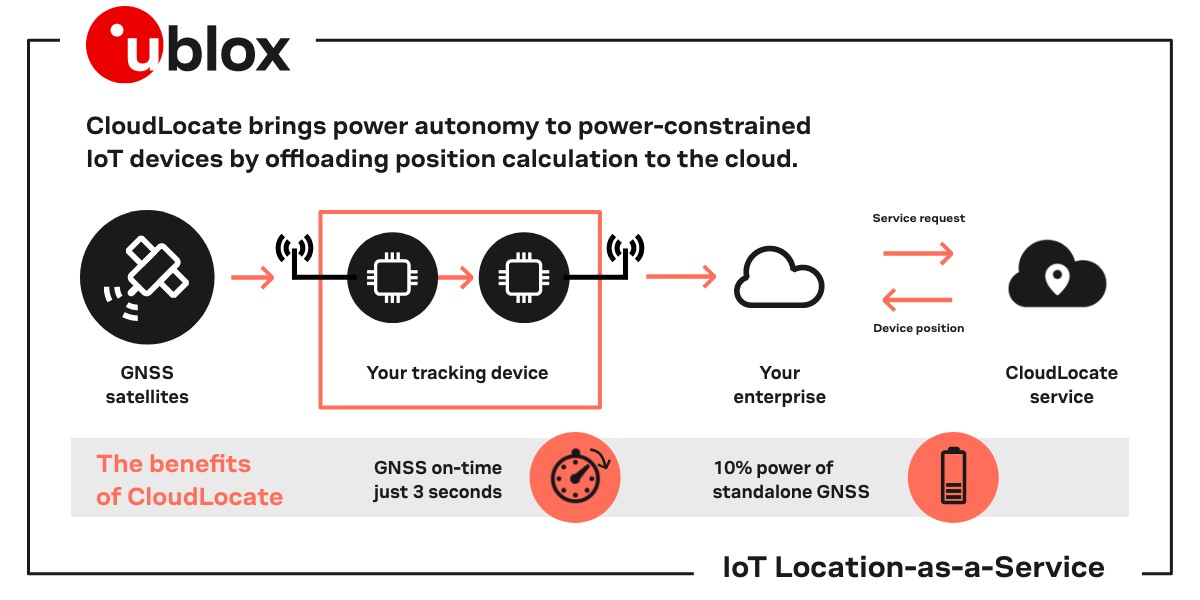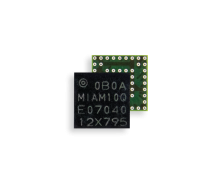
Tech
|
07 Oct 2022
Cloud-based positioning meets LoRaWAN
u-blox cloud-based positioning solutions bring distinct advantages to power constrained applications using LoRaWAN® technology.

On a quest for ultra-low-power IoT applications, many IoT project designers choose LoRaWAN® network technology. However, because LoRaWAN provides low bandwidth, there is often a trade-off required. A vast portion of IoT devices need meter-level location accuracy to do their job, prompting the design quest to expand to GNSS (global navigation satellite system) solutions. This article describes how the u-blox cloud-based positioning solution makes a perfect match for use with LoRaWAN, allowing for best-in-class synergy between GNSS technology and long-range wireless connectivity for power constrained IoT devices. The combination provides a real-world developer platform from our customer Move-X where cloud-based positioning meets LoRaWAN.
| u-blox is holding a webinar on cloud-based positioning delivering power autonomy to your asset-tracking application. This will be held in conjunction with Digi-Key on Thursday, April 6th. For more information please click here |
The quest for ultra-low power using LoRaWAN
Today’s IoT project designers are continuously looking for opportunities to reach new ultra-low levels of power consumption for constrained IoT applications such as asset tracking; supply chain and logistics management; smart agriculture; smart cities; environment monitoring; infrastructure monitoring. This quest leads designers to consider LoRa (short for long range), a leading non-cellular low-power wide-area (LPWA) network technology. LoRaWAN radio connectivity can be a economical solution for energy constrained use cases.
Brings with it key trade-offs between power consumption and position accuracy
However, a key shortcoming of LoRaWAN is precisely what it touts as its strength: low bandwidth. Compared with Cellular connectivity, for example, due to the frequency bands it utilizes, LoRaWAN doesn’t allow continuous messaging, making it suitable only for short periodic communications.
There is enormous growth in connected devices globally, and a vast portion of IoT devices need location information to do their job. While LoRaWAN offers distinctive low power benefits that make its GPS-free geolocation feature seem like an attractive alternative to a more traditional power hungry GNSS approach, its location accuracy is insufficient for many IoT applications that require <10 meter location accuracy. This is where GNSS receiver modules come into design consideration.
Traditional standard precision GNSS modules deliver meter-level accuracy but can be relatively power hungry while doing it. A real-world power hog scenario for stand-alone GNSS receivers is taking tens of seconds or even minutes to establish a position fix. To address this, typical location solutions bring with them the ‘hidden’ connectivity bandwidth requirement of needing assistance data to achieve a faster time-to-first-fix (TTFF), reducing the on-time to mere seconds.
IoT project designers making key trade-off decisions between bandwidth, location accuracy, energy consumption, and device size can consider innovative cloud-based positioning solutions from u-blox. The solution complements LoRaWAN, solves these trade-offs, and answers the power autonomy imperative.
Solved by positioning in the cloud
u-blox M10 ultra-low-power GNSS receiver modules in combination with CloudLocate, the u-blox positioning in the cloud service, are ideally suited for power constrained applications that require large power autonomy, a reasonable position accuracy of a few meters, a few location updates per day, and where location information is not used on the device itself, but rather by a cloud service. This innovative positioning solution brings power autonomy to constrained IoT devices by offloading position calculation to the cloud. Because the GNSS signals are preprocessed on the receiver, the solution works with a tiny data packet size of 12-50 bytes. CloudLocate uses only the uplink connection to the cloud to resolve position and without the need for assistance data, making this technology the perfect complement for a low bandwidth LoRaWAN solution that also requires meter-level position accuracy.

GNSS meter-level accuracy
Many IoT applications such as asset tracking require <10-meter location accuracy to do their job, making features like LoRaWAN geolocation with 10-50 meters location accuracy insufficient for the task. That is where u-blox M10 standard precision GNSS modules come into play, delivering horizontal accuracy of 1.5m CEP (circular error probable). The MAX-M10 supports concurrent reception of four GNSS (GPS, GLONASS, Galileo, and BeiDou). The high number of visible satellites enables the receiver to select the best signals. This maximizes the position availability, under challenging conditions such as in deep urban canyons. u-blox Super-S technology offers great RF sensitivity and can improve the dynamic position accuracy by up to 25% with small antennas or in a non-line-of-sight scenario.
Months or years of battery life using GNSS and CloudLocate
As you would expect, the u-blox MAX-M10S GNSS modules are designed to operate with extremely low power consumption, using less than 25mW in continuous tracking mode, without compromising GNSS performance.
The overall power consumption can be drastically reduced by minimizing the time that the GNSS receiver is switched on and by outsourcing the power-intensive position calculation off the device and to the cloud. The innovative technology underlying CloudLocate does exactly that, saving up to 90% of power consumption and acquisition time compared to a standalone GNSS doing a cold start in 30s time. In most cases, position accuracy using CloudLocate will be under 5 meters, which means developers can achieve GNSS position accuracy combined with low power consumption. A position request can consume as little as 25 uW/h. This technology enables months or even years of battery life, a power autonomous IoT device can spend more active time doing the job in the field and less downtime charging batteries or being swapped out.
Low bandwidth
When it comes to IoT project design trade-offs, the low bandwidth provided by LoRaWAN radio connectivity is also its shortcoming, narrowing the application scope to those that need only short periodic communications at low data rates in the range of 0.5-25kbit/sec. Under these limited bandwidth conditions, there are several differentiated advantages offered by the u-blox cloud-based positioning solution:
1. Only the uplink is needed
CloudLocate only uses an uplink connectivity to the cloud to resolve position. First the GNSS signals are pre-processed on the receiver, then a data packet size of 12-50 bytes is transmitted to the cloud, where the power-intensive position calculation is outsourced from the device. No downlink is needed, because location information is not used on the device itself, but rather by a cloud service. In this way, CloudLocate is ideally suited even for IoT applications in limited bandwidth networks such as LoRaWAN that have no suitable downlink.
2. A-GNSS (assisted GNSS) aiding data is not needed
Under adverse signal conditions, data downloads from the satellites to the GNSS receiver can take minutes, hours or even fail altogether. A-GNSS accelerates calculation of position by delivering satellite data such as ephemeris, almanac, accurate time, and satellite status to the GNSS receiver via wireless networks or the internet. This aiding data enables a GNSS receiver to compute a position within seconds, even under poor signal conditions. A‑GNSS provides faster Time‑To‑First‑Fix and improved accuracy and position availability, benefits that directly translate to lower power consumption and larger power autonomy.
To use A-GNSS, communication networks must support a capable downlink, because the data package is always at least a couple of kB. This downlink capability is not the case for networks like LoRaWAN. With CloudLocate, the device position is resolved in the cloud and without the need for the download of A-GNSS assistance data, overcoming the bandwidth limitations of LoRaWAN while delivering location data to the cloud enterprise, and with large power autonomy.
3. Handles the no connectivity use case
In case there is a lack of connectivity, a typical stand-alone positioning device would not be able to download assistance data, and this would result in higher GNSS on-time and higher power consumption. With the u-blox cloud-based positioning solution, the MAX-M10S can always take (one or more) snapshot data packets of 12-50 bytes each and send it to the MCU and to CloudLocate later for post processing. This is the optimal solution to save power, for example, in remote regions where connectivity is sporadic or absent.
Miniature chip-sized module options
When IoT designers start adding the necessary GNSS receiver components to the board, space often becomes an important consideration in the overall IoT project. Constrained IoT device applications also need to compact to address size-constrained applications such as wearables. At 100mm2, the well-known ‘MAX’ form factor allows for easy integration. The latest in the u-blox M10 GNSS platform, MIA-M10, delivers ultra-low-power for miniature asset-tracking devices with a 20mm2 chip-sized module and without requiring external components. Such compact form factors enable small size without sacrificing GNSS performance.
A real-world solution from Move-X
We are pleased to share that our customer Move-X has chosen to integrate a u-blox cloud-based positioning solution in their new LoRaWAN radio connectivity solution - the Cicerone board. The Cicerone board is built around the Move-X MAMWLE module, a powerful radio module that provides both LoRaWAN connectivity and processing power for the user application. The board is compliant with Arduino MKR form factor and embeds the best-in-class u-blox MAX-M10S GNSS module in combination with CloudLocate position in cloud service. It can be operated through a single-cell LiPo battery and embeds a charging circuit, to provide up to 10 years of battery life. Cicerone is an ideal platform for developing IoT projects using cloud-based positioning and LoRaWAN.

A perfect match: Cloud-based positioning and LoRaWAN
u-blox’s cloud-based positioning solution, M10 + CloudLocate, makes a perfect match for use with LoRaWAN, because this combination allows for best-in-class synergy between GNSS technology and long-range wireless connectivity for power constrained IoT devices. Ideally suited for applications that require meter-level accuracy, including asset tracking; supply chain and logistics management; smart agriculture; smart cities; environment monitoring; infrastructure monitoring.
Contact us for more information.
Note: LoRaWAN® is a mark used under license from the LoRa Alliance®.


